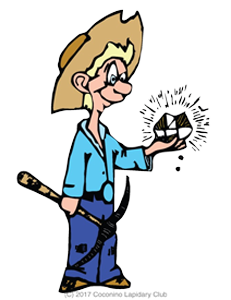I’ve been an avid collector of mineral specimens from around the world since my experience, at the age of 13, of finding a beautiful black tourmaline crystal while on a Boy Scout hiking adventure. We were in the upper limits of the gem mining Pala District in San Diego County, California. I’m now 84 and still. . . Read More
Mineral Man Mel
Who Is That Masked Mineral Man?
What is the Difference Between a Rock and a Mineral?
According to the USGS website, “A mineral is a naturally occurring inorganic element or compound having an orderly internal structure and characteristic chemical composition, crystal form, and physical properties”. “A rock is an aggregate of one or more mineral, or a body of undifferentiated mineral matter”. For more information about rocks and minerals, be sure. . . Read More
On Wulfenite
Today my main topic is the mineral Wulfenite which has a strong association with Arizona. Lead mines, in which Wulfenite has been found, are numerous, with some of them offering such beautiful examples of the mineral that they have become classic localities. Among these are the Rowley Mine and the Glove Mine. More photos of. . . Read More
Copper Mining in Bisbee
Thanksgiving Day 2017, my son Greg and I traveled to the old copper mining town of Bisbee for a two day exploration of the Bisbee Mining and Historical Museum, observing the, now non-operational, Lavender Open Pit Copper Mine, and soaking up the ambiance of this charming town perched on the low hills of the Mule Mountains. [Ref. . . Read More
USE OF COLOR IN MINERAL IDENTIFICATION
In some minerals color is directly related to a metallic element, is characteristic, and can be useful in identification. As examples, azurite as shown in Figure 1A, is always blue due to the presence of copper, and rhodochrosite, shown in Figure 1B, is always pink to red due to the presence of manganese,. However minerals such as fluorite, colorless in it self, can be yellow, blue, purple, or green due to low concentrations of metal impurities.
USE OF CRYSTAL FORMS AND HABITS IN MINERAL IDENTIFICATION
The atoms within the crystal of a mineral are arranged in a regular fashion to form a lattice, and the crystal exhibits a shape with surface regularity which reflects its internal symmetry[Ref1]. The shape of a crystal is often typical of a mineral. and often typical the location where found; thus, crystal shape comprised of crystallographic forms modulated by crystal habit can be a useful tool in mineral identification.
USES OF CLEAVAGE, PARTING, AND FRACTURE IN MINERAL IDENTIFICATION
Cleavage in a mineral is the tendency for the crystal to split along definite crystallographic planes as exemplified by the rhombohedron cleaved from a calcite crystal shown in Figure 1[Ref1]. These planes of weakness are present within a regular repeating array of atoms and ions within the crystal and are always parallel to a potential face of the crystal.
FRACTURE IN MINERAL IDENTIFICATION
Fracture in mineralogy is the texture and shape of the surface formed when the mineral is fractured. Fracture differs from cleavage and parting, which involve clean splitting along a plane surface, as it produces rough irregular surfaces [Ref1]. The appearance of fracture surfaces among minerals is highly varied and is a useful tool in identification. In this part of my Blog I’ll describe the fracture surfaces broadly seen in minerals.
GALLERY OF CHINESE CARVED JADE ART
o the great advantage of the beauty of their art, Chinese carvers of jade were guided by themes and decorative motifs in the shaping of their carvings and the choices of decorative motifs adorning them[Ref1-7].
HISTORY OF JADE CARVING IN CHINA
From the late Neolithic Age (circa 3500 BC-2070 BC) into today the crafting of jade art objects in China has produced beautiful and magnificent art objects which exhibit remarkable diversity of both color and form as shown by the carved nephrite jade pendant with phoenix pattern and the funerary Bi Disc with rain pattern in Figure 1[Ref1]. In this blog I’ll describe the tools and techniques with their technological advances and show corresponding art objects of increasing complexities of design and execution.
